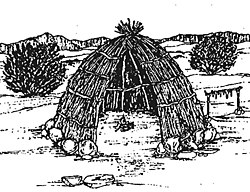Wigwam
A wigwam, wickiup, wetu (Wampanoag), or wiigiwaam (Ojibwe) was a type of home for Native Americans. The homes were often shaped like domes and were round.[1] It is different than a longhouse or tipi. Wigwams were common in the Northeastern Woodlands. They were also in the Southeastern Woodlands and the Western United States. Wood was used for the frames. Materials to make roofs included bark, hides, grass, brush, rushes, mats, reeds, or cloth. The homes were good against many types of weather conditions. Wigwams were built by bending young trees and placing them along a circle.[2] Different native groups had different names for the wigwam. Wigwam was used in the Northeastern Woodlands. The term wickiup was used in the Southeast and Western regions.[3]
- ↑ "Definition of WIGWAM". www.merriam-webster.com. Retrieved 2022-07-31.
- ↑ "Wigwam | The Canadian Encyclopedia". www.thecanadianencyclopedia.ca. Retrieved 2022-07-31.
- ↑
Wigwam Media
Apache wickiup, by Edward S. Curtis, 1903
Dakota-style tipis and Ojibwe wigwam, White Earth, Minnesota, 1928
Ojibwe wigwam, from an 1846 painting by Paul Kane
Illustration of an Acjachemen wickiup, California
Frame of Apache wickiup
Chiricahua medicine man and family in wickiup
"Wigwam - New World Encyclopedia". www.newworldencyclopedia.org. Retrieved 2022-07-31.









